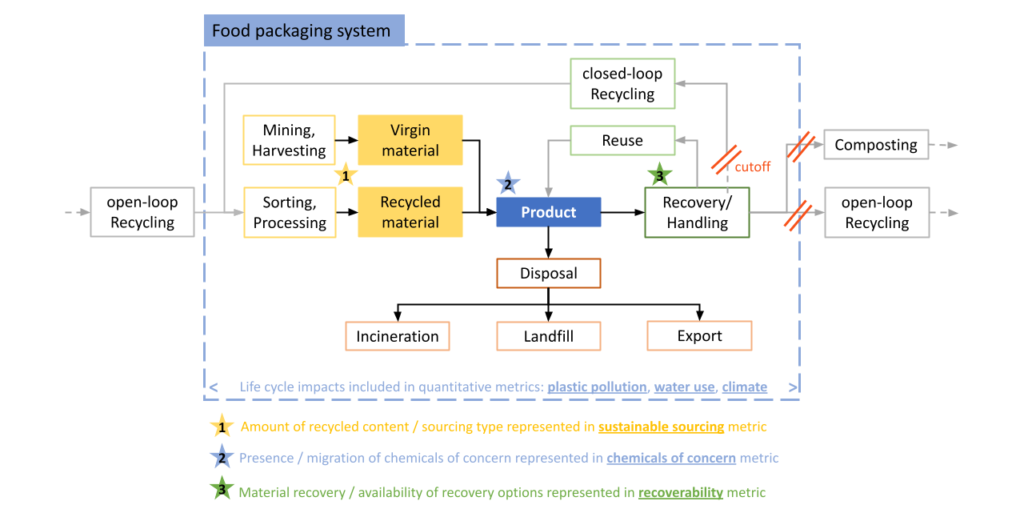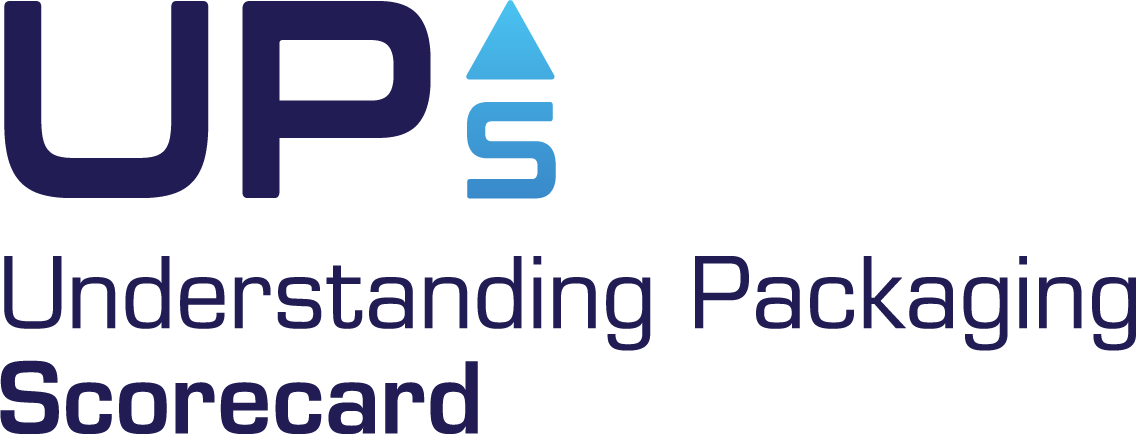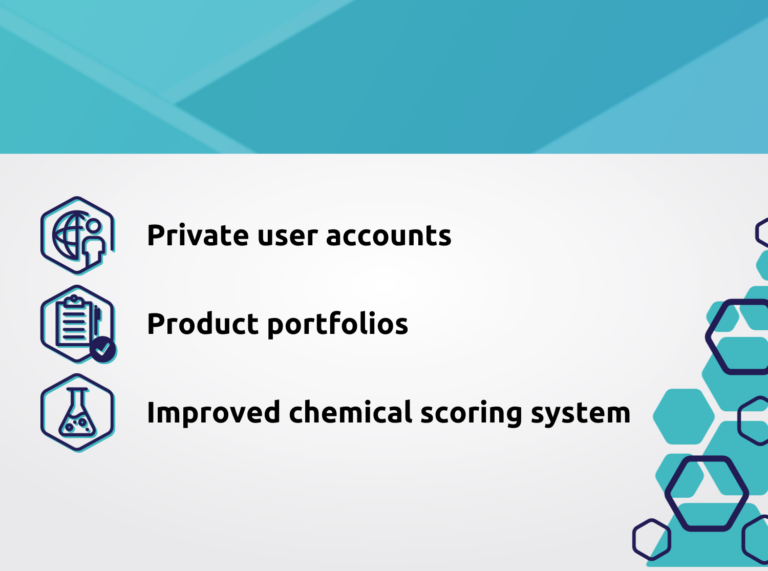For foodware and food packaging, achieving true circularity has been challenging. Reuse systems are now starting to spread slowly, but there are still operational and cost-effectiveness issues that need to be addressed in order to make them more “frictionless” and attractive for the user. The recycling of food packaging waste into new food packaging also remains limited, and concerns about chemical safety are compounding the difficulty. Nevertheless, it is becoming increasingly clear that food packaging needs to move away from a linear and toward a more circular value chain to make a next step toward circularity and holistic sustainability.
In a circular economy, the functionality of products and materials is maintained for as long as possible, while raw material use, energy inputs and waste production are minimized. The concept of circularity is often referred to in the context of end-of-life decisions when the task is to “responsibly manage” a particular material or waste stream. However, decisions during the whole product life cycle are relevant for circularity. The UP Scorecard accounts for supply chain and waste management activities, as well as product design and regional recycling infrastructure.
Circularity in the UP Scorecard
Circularity is a systems concept, and so the UP Scorecard does not assign a single “Circularity” score. The Scorecard uses a hybrid scoring approach with six metrics. Three are quantitative numerical estimates and three are qualitative attributes-based scores. An overview of the six metrics is available, where you can also find links to more detail about the UP Scorecard methodology. Elements of circularity affect all six of the UP Scorecard’s sustainability metrics.
For circularity, one of the most important attributes of a product (foodware or otherwise) is whether or not it is designed to be reusable (see EU waste hierarchy Article 4 and US EPA waste hierarchy). To reflect this, the user of the Scorecard is prompted to always choose at least one reusable option when comparing products. Even if a user does not think a reusable system is an option for a particular situation, it is a reference point and an explicit reminder that the decision space could include reusable systems.

Circularity in the quantitative metrics based on life cycle assessment
Three of the six metrics included in the UP Scorecard are based on life cycle assessment (LCA). These are the quantitative metrics Climate, Water Use, and potential for Plastic Pollution. We use a “cutoff” method to account for recycling and end-of-life management (also called the “recycled content” method). The term “cutoff” refers to the fact that some material that leaves the LCA model is “born again” – it is a byproduct of the system, as defined by the modeler, and it is available to other users free of environmental impacts. It is often referred to as the “recycled content” method, for reasons which we hope to make clear below. We will use the term “cutoff”, but it should more properly (and even more clumsily) be called the “cutoff/recycled content” method.
We adopt the cutoff method because it avoids the allocation of “credits” from further downstream uses, which are difficult to track and verify. With the cutoff method, recycling is viewed as a material supply system, and not a waste management system. Producing recycled content that is suitable as a raw material in food packaging and food wares requires resource inputs (to sort, transport, and reclaim the materials). These resource inputs are assigned to the product using the recycled material. If a recycled material has lower impacts than the virgin material alternative, the use of recycled content will reduce the impacts of the product using the recycled material.
With the cutoff method in LCA, the impacts from a product’s end-of-life depend on the path it takes. This results in different accounting of impacts, depending on whether and how the product is recovered:
- Product is recovered (reuse, recycling, composting): After a product or material is collected and delivered to a materials recovery facility (MRF) or other processing facility, the material leaves the system boundary. This raw material is now available, free of burden, for the production of a next product. Regardless of whether the material is used in a “closed-loop” recycling system, or an “open-loop” recycling system, the end-of-life accounting is the same: Impacts of collection and delivery to a processing facility are attributed to the original product. Impacts of sorting and processing are assigned to the user of the recovered material (not the originator).
- Product is disposed (incineration, landfilling, export): If the product is not recovered, and is instead disposed of, any emissions associated with the disposal are assigned to the original product. If the product is incinerated, emissions are attributed to the original product, even in cases where energy recovery is available.
This cutoff method for LCA does benefit circular systems. In the least, impacts from disposal are mostly avoided when material is recovered. In addition, recycled content usually has a lower impact than virgin material.
Circularity in the qualitative Recoverability and Sustainable Sourcing metrics
The qualitative Recoverability and Sustainable Sourcing metrics serve as compliments to the quantitative (LCA-based) metrics. One shortcoming of the cutoff LCA method is that it sometimes provides only a small incentive to improve circularity. For example, emissions from landfilling plastic waste are relatively small, so avoiding this activity provides a small benefit. With the cutoff method, the process of recycling does not receive any avoided burden credits. We think this is the correct approach for the LCA models. However, it must be acknowledged (and rewarded) that design for recovery and the acts of recycling themselves enable the re-use of resources, and without the many steps in the recycling chain, recycled content would simply not be available.
The Recoverability metric rewards products according to multiple circularity measures. Reusable products get the highest Recoverability score, since they largely avoid the need for disposal. Compostability is also rewarded, depending on a product’s certification. In order for a recyclable product to be rewarded, its design must be optimized for recycling, and recovery infrastructure must be available and accessible.
The Sustainable Sourcing metric provides further incentive for circularity, and it also rewards practices that are likely to improve environmental performance in areas other than the three LCA metrics. It most highly rewards reusable products. Certain types of materials are rewarded according to their amount of post-consumer recycled content, which reduces the need to extract virgin material. This reward is in addition to the effect of the use of recycled content on water consumption, plastic pollution, and greenhouse gas emissions covered with the quantitative (life cycle based) metrics. Due to current concerns about chemical contamination from recovered materials (and corresponding regulations), the Sustainable Sourcing metric only rewards recycled content in metal (aluminum and steel) and glass products, as well as in PET bottles. Furthermore, the sustainable sourcing metric rewards sustainable agriculture and forestry practices for bio-based materials like carton or paper.
Chemicals and circularity
Often, little or no attention is paid to chemicals (and especially chemicals of concern) in products and materials that should become more circular and sustainable. However, the focus on chemicals is essential (besides all the other relevant factors) when making food packaging more circular. This concerns in particular the closing of recycling loops to enable the manufacture of products with similar quality and safety standards. To make this possible, hazardous chemical components should be either phased out entirely at the design stage of a product, or, if no design alternatives exist, effectively managed during each recycling cycle. The UP Scorecard’s Chemicals of Concern metric makes this challenge explicit, and it calls for action for more transparency and knowledge about (potentially) present chemicals of concern in food packaging. You can read more about the chemicals of concern metric in our earlier blog articles about using the CoC metric and making the most of the FCOC List.
Improving the circularity of a product
Based on the above, there are different ways the circularity of a foodware or food packaging product can be improved in the UP Scorecard by the user. Some of them are to:
- Use the product only when it is really needed. If possible, reduce the quantity.
- Switch from a single-use to a reusable product.
- Increase the number of uses when using reusable products.
- Increase the recycled content in a product when the material involved is recyclable.
- Reduce the presence of chemicals of concern and use more inert materials that make chemical migration less likely.
- Optimize a product for recovery and make sure the respective recovery facility is available. Indicate a composting certificate for bio-based materials.
- Make sure bio-based materials are sourced from sustainable agriculture and forestry practices.
- Use products made of single materials and without coatings (if possible).
A circular UP Scorecard
As shown in the explanations above, the UP Scorecard not only covers the quantitative impacts of circularity on a product, but it also rewards circular practices and efforts in all of the six available metrics, given that these efforts also include a strict management/avoidance of chemicals of concern. At the same time, the UP Scorecard also directs attention to the difficult and challenging aspects of circularity, including sustainable sourcing of bio based-materials, composting certifications, availability of facilities for material recovery, and the presence/potential migration of chemicals of concern. These aspects are very important when discussing circularity and are also included in the assessment of the UP Scorecard.
Circularity affects very different aspects of a product’s life cycle. The UP Scorecard takes this into account by (I) including widely recognized fundamental aspects of circularity in all existing metrics and (II) also pointing out further important aspects to consider when going circular that are not yet widely being considered.

About the authors
Florian Suter
Florian is Scientific Officer and Project Manager at the Food Packaging Forum Foundation and is coordinating the UP Scorecard project. An environmental scientist and environmental educator by training, he works at the nexus between the environment and human health to bridge the still existing gap and to help decision-makers understand, convey and apply the needed knowledge.

Kyle Meisterling
Kyle is an LCA practitioner at Scope 3 Consulting. He has been an author and co-author of several high-impact publications on the life cycle assessment of fuel cycles, food systems, and transportation options. He is passionate about building Life Cycle Models that help clients optimize their sustainability investments.






